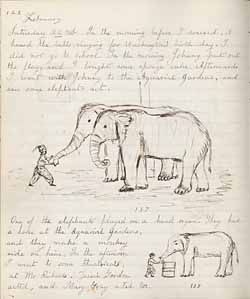Sarah Gooll Putnam diary 2, entries for 22-23 February 1862, pages 128-130
To order an image, navigate to the full
display and click "request this image"
on the blue toolbar.
In these entries from her diary, eleven-year-old Sarah Gooll Putnam describes and illustrates her visits to the Boston Aquarial Gardens, in February of 1862. The Aquarial Gardens, the first aquarium in Boston, were a popular attraction, presenting exhibitions of rare marine and zoological specimens, as well as theatrical and musical entertainment.
Sarah Gooll Putnam and her diary
Born 19 March 1851 into a well-connected Boston family, Sarah Gooll Putnam showed an early interest in and aptitude for art. In a note appended to the first volume of Putnam's diary, her mother, Harriet Putnam, writes, "She was very happy always, and amused herself. A great part of her time was spent in imagining herself a horse, and prancing around the shrubbery, and in trying to be an Artist."
Sally Putnam fulfilled this early promise, becoming a respected portrait painter and watercolorist at a time when few women were able to pursue an artistic career. After studying art in New York, Munich, and Holland, Putnam painted many oil portraits of family members, friends, and other prominent Bostonians. Putnam's work was successfully exhibited in Boston, New York, and Chicago, including two shows at Boston's St. Botolph Club, a Boston social club founded in 1880 that was the preeminent venue in Boston for exhibitions featuring both established and emerging artists.
Putnam was nine years old in November 1860 when she began her diary, which she kept until near her death at age sixty-one in 1912. In chronicling her daily life and extensive travels (including vacations at her family's summer homes in Andover and Nahant, Massachusetts, as well as several trips to Europe), Putnam illustrated her diary with numerous sketches and watercolors, beginning with her expressive childhood drawings and including copies of and sketches for her professional work. She also pasted photographs, postcards, and letters written while traveling into her diary.
What were the Aquarial Gardens?
After observing aquarial exhibitions during his travels in England in the 1850s, famed showman Phineas T. Barnum devised plans to offer similar entertainments in the United States. Barnum's American Museum in New York featured aquarial exhibits as early as 1856, and in 1859, Henry D. Butler, one of Barnum's partners in the museum, joined with Boston inventor and aquarist James Ambrose Cutting to open the Boston Aquarial Gardens on Bromfield Street. The first recorded aquarium that was not part of a larger institution, the Boston Aquarial Gardens aimed to educate and entertain the public with displays of exotic marine life.
In October 1860, the renamed and expanded Boston Aquarial and Zoological Gardens moved to Central Court, off Washington Street. A great central tank, twenty-five feet in diameter, ringed by fifty-six smaller tanks, dominated the street level of the hall, while the zoological department occupied the lower level. Typical Barnum fare, including performing elephants, trained bears, fortune-tellers, and the white beluga whale described by Sally Putnam soon joined the educational exhibits of marine animals.
P. T. Barnum himself assumed ownership of the Gardens (renaming them "Barnum's Aquarial Gardens") in 1862. This new incarnation relied less on the aquarial attractions, featuring instead a "Great National Dog Show," followed by a Baby Show, visits from Barnum performers, including Tom Thumb, and theatrical entertainments. Despite this diversification--or perhaps because of it--Barnum's Aquarial Gardens closed in February 1863, possibly due to competition from the nearby Boston Museum and Gardens on Tremont Street. Barnum removed himself and the contents of the Aquarial Gardens to his American Museum in New York, where the majority of the exhibits were destroyed in a fire in 1865.
Suggestions for further reading
Pipkin, Erin. " 'Striking in its promise': The Artistic Career of Sarah Gooll Putnam," Massachusetts Historical Review, vol. 3, 2001, p. 89 - 115.
The twenty-seven volumes of Sarah Gooll Putnam's diary provide a wonderfully vivid glimpse into the life of a perceptive and talented child and woman artist in 19th century Boston. This is but one of the many diaries in the Society's collections available for historical research. Please visit our website for more information about the Society's holdings.
See the online finding aid to the Sarah Gooll Putnam diaries, including an index of photographs in the volumes.
Ryan, Jerry. The Forgotten Aquariums of Boston. Pascoag, R.I.: Finley Aquatic Books, 2002.
The website of the New England Aquarium features a historical sketch of aquariums in Boston , including a detailed account of the Aquarial Gardens.

